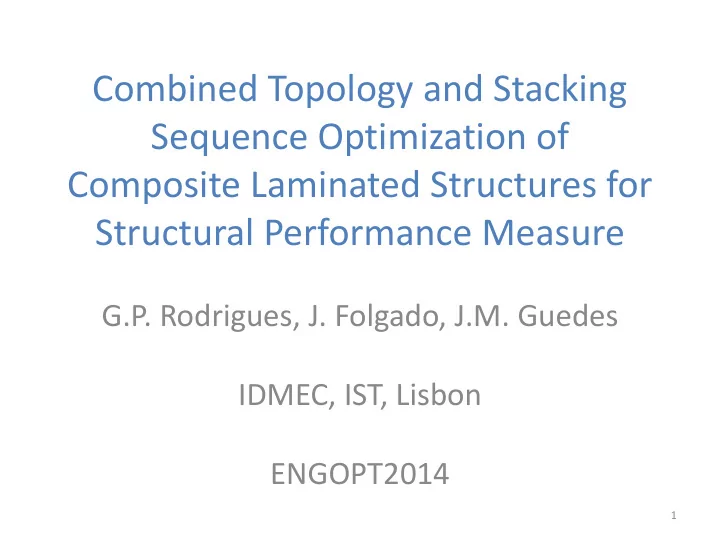

Combined Topology and Stacking Sequence Optimization of Composite Laminated Structures for Structural Performance Measure G.P. Rodrigues, J. Folgado, J.M. Guedes IDMEC, IST, Lisbon ENGOPT2014 1
Summary • Composite materials • Discrete Material Optimization (DMO) • Maximize stiffness • Sensitivity analisys • Finite Element Analisys – Abaqus • Feasible Arc Interior Point Algorithm (FAIPA) • Results and conclusions 2
Discrete Material Optimization* • Transforms the discrete optimization problem into a continuos one • Constitutive matrix is composed by a weighted sum of the matrices from the candidate materials • Weights are function of material variables • Variables and weights tend to limit values of 0 or 1 • DMO scheme 4 *J.Stegmann & E.Lund (2005) Discrete Material Optimization of General Composite Shell Structures 4
Candidate Materials • Composite material – Orthotropic material – Different fiber orientations – 0º, 90º, 45º and -45º • Foam material – Isotropic material – 250x less stiff – 20x less dense 5
Design regions and convergence • Structures divided in areas “j” and laminas “k” • Laminas and areas corresponde to design regions “r” • Obtain defined material in each design region • Material weights to limit values 0 and 1 • Convergence assumed with weights of 0.95 6
Optimization functions Subjected to: • Box constraints – project values go between 0 and 1 • Equality constraints – force weights with limit values (0 and 1) • Inequality constraints – minimum number of foam regions 7
Sensitivity Analisys • Derivative of the objective function → Adjoint Method • Derivative of the equality and inequality constraints 8
Feasible Arc Interior Point Algorithm (FAIPA) • Programmed in Matlab • Requires initial feasible point • Considers KKT conditions for optimality • Line search: Armijo, Wolfe and Goldstein • Uses “Feasible direction” or “Feasible descent arc” • Permits Newton, Quasi-Newton and First Order Methods 9
Abaqus – Finite Element Model Advantages: – General FEA code and permits to study complex/generic structures – Numerous shell elements available (e.g. S3, S4 , S4R and SAX1) Disavantages: – Computacionally heavy – Works as a black box – Difficulties to extract data S4 Shell element: – 4 node shell element based on FSDT – Without reduced integration (with capabilities to prevent locking ) – Allows the user to define layers – Recomended for thick shells and composite thin shells – May not perform very well for sandwich laminates 10
Penalty function • FAIPA uses Feasible solution method • Difficulties in convergence due to unfeasible starting points • Introduce penalized functions in FAIPA 11
Program description Define Develop Optimization optimization Pre-Optimizer Results sructural model (FAIPA) parameters Pre-Optimizer: Optimization (FAIPA): – Call Matlab – Call Abaqus and obtain solution – Initialize parameters – Read output – Read Abaqus input file – Calculate derivatives (write assembly matrix) – Increment penalty exponent and – Call Abaqus (obtain stiffness coeficients matrices) – Iterate until convergence Results: – Writes in Matlab, Excel and text files – Design points, objective values and material weights 12
Results (Laminate) • Square plate with 10 laminas • Subjected to uniform pressure (P) and variable traction load (T) • Include 2 foam layers 13
Results (Combined Topology) • Foam material can be adjusted to become “weaker” and perform topology optimization • Square plate with 400 areas • Case studies: – Concentrated load in fixed plate (a) – Central pressure in simply supported plate (b) 14
Results (Combined Topology (a)) 100 foam areas 200 foam areas 300 foam areas • DMO allows us to perform topology optimization • The more foam we introduce the more difficult it is to achieve convergence 15
Results (Combined Topology (b)) • Shows the areas to be reinforced with composite materials 16
Results (different coordinate systems) • 2 plate areas with different local coordinate systems • Each area with 5 layers • Fixed in one edge • Case studies: – Concentrated load – Traction and bending – Shear edge load • Include foam 17
Results (different coordinate systems (a)) 18
Results (different coordinate systems (b) 19
Results (different coordinate systems) 20
Discussion and Conclusion • General good results and high convergence • DMO creates many local minimums and design variables • A proper parameters choice has to be performed (the designer experience is relevant) • Penalty function with FAIPA performs well • Code developed is limited to S4 elements but easilly extended to other • For higher amounts of foam convergence is more difficult • Equality constraints helps to overcome some material mixtures • Extend to multi-load optimization • Adapt code to various kinds of other elements 21
Acknowledgements This work is supported by the Project FCT PT DC/EME-PME /120630/2010 22
Recommend
More recommend